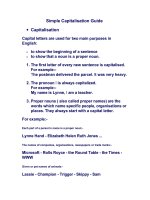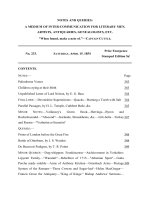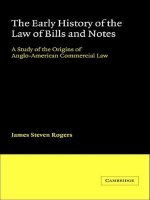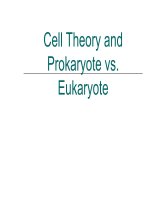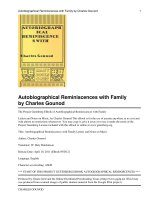- Trang chủ >>
- Đề thi >>
- THPT Quốc Gia
s2014 notes
Bạn đang xem bản rút gọn của tài liệu. Xem và tải ngay bản đầy đủ của tài liệu tại đây (225.08 KB, 6 trang )
STUDY NOTES
FORMAL WRITING – LANGUAGE
STRUCTURES
The academic module of the IELTS writing
test assesses a variety of different skills,
including interpreting graphic information,
writing a well-structured argument,
presenting a solution to a problem, clarifying
and supporting ideas, organising
information logically, comparing and
contrasting evidence, using appropriate
language structures and others.
These skills are examined over the range of
possible IELTS writing question types in
both Task 1 and Task 2.
EPISODE 14: TERMITES
STUDY TIPS
Remember there are particular
language features, which
characterise the different question
types assessed in the academic
IELTS writing module.
Be aware of which verb tense, voice
or modal verb is the most
appropriate for each text type, and
which transition signal allows you to
best express your ideas.
Focussing on the skill of using appropriate language structures specifically, we
can identify the main features, which characterise the different question types
examined in the IELTS Writing test.
Writing Task 1 types
There are several text or question types, which are used to assess your writing
ability. These include:
describing and interpreting line graphs, tables, bar charts and other
graphic information
describing the stages of a process or procedure
describing and explaining how something works
describing a cycle
Using appropriate language structures
It is important to demonstrate in the writing task that you have a good understanding
of the text type. This means being able to use appropriate language structures for
that question type.
The table on the next page provides a summary of those language structures, which
characterise features relevant to each of the text/question types.
Page 1 of 6
Text type
Describing and interpreting graphic information
Language structures
Subjects
variety of subjects
the line graph…; the size of the…; this pie chart…; the number
of…; a/the majority of…; a/the minority…; a small portion…;
a/the large number of; most…; most of…; a/the percentage of;
fifteen percent of…; there was a….; the tourists…; the
participants…; the table…; just over a quarter…; almost a
half…; several…; several of…; some…; some of…; a tendency
Verbs
verb tenses –
simple past;
expressions for the
future
used to describe definite dates and times which happened in
the past;
when talking about future changes use expressions such as: it
is predicted; it is projected; it is forecast; it is estimated
verbs referring to
change or trends
rise; fall; drop; increase; decrease; decline; remain stable; peak;
reach a peak; level off; double; triple; grow; tend; stabilise;
plateau
Adjectives and Adverbs
describing the size
and speed of
change
slight(ly); sharp(ly); steep(ly); slow(ly); rapid(ly); significant(ly);
dramatic(ally); steady(ily); gradual(ly); noticeable (noticeably);
negligent(ly); considerable(ly)
Comparing and Contrasting
variety of different
comparative and
contrastive
structures
comparative structures
comparatives/superlatives: bigger; better; smaller; fewer; more;
less; as … as; least; biggest; best; smallest; most
expressions: alike; like; prefer; preferable; favour; favourable;
similarly; likewise; twice as much/many; three times as
much/many
contrastive structures
however; on the other hand; conversely; although; in spite of;
despite; in contrast to; whereas; while; unlike; different from;
greater than; more than; less than; nevertheless
Page 2 of 6
Text type
Describing the stages of a process or procedure
Language structures
Verbs
passive voice –
present passive for
a general
description;
past passive when
referring to a
specific event in the
past
imperatives for
giving instructions
simple present passive: is/are + participle
is connected; are manufactured; is cut ; are dried; is thrown; is
shipped; are measured
present continuous passive: is/are + being + participle
is being connected; are being dried; is being measured
simple past passive: was/were + participle
was harvested; were dried; was manufactured; were
transported; was completed; were sent
past continuous passive: was/were + being + participle
was being harvested; were being dried; was being
manufactured;
boil the water…; connect the hose…; switch off the power… or
one must boil the water…; one needs to connect the hose…
Chronological order or sequence
subordinate
conjunctions
showing time
relationships
as; as soon as; as long as; after; before; since; until, the
moment that; when; while; whenever; once
subordinate
conjunctions
showing purpose
in order to…; so that…; in order that…; which results in…
sentence
connectors
indicating
sequence
first…; firstly…; first of all…; first and foremost…; second…;
third…; next…; at once…; then…; after that…; meanwhile…;
finally…; last…; lastly…; subsequently…; now…
Page 3 of 6
Text type
Describing and explaining how something works
Language structures
Verbs
active –
active and passive
voice; present and
past tenses
infinitives of
purpose
simple present: send(s);
present continuous: is/are sending
simple past: sent
past continuous: was/were sending
passive – simple present: is/are connected
present continuous: is/are being
connected
simple past: was/were connected
past continuous: was/were being connected
in order to attach…; so as to reflect…; so as not to burn…
Prepositions
prepositions of
position
below; beneath; in front (of); next to; inside (of); on top (of);
above; behind
Chronological order or sequence
sentence
connectors
indicating
sequence
first…; firstly…; first of all…; first and foremost…; second…;
third…; next…; next to…; then…; after that…; meanwhile…;
finally…; last…; lastly…; subsequently…; now…
Writing Task 2 types
There are several different text or question types, which are used to assess your
writing ability, and include:
presenting an argument
presenting a solution to a problem
presenting an opinion or point of view
Using appropriate language structures
It is important to demonstrate in the writing task that you have a good understanding
of the text type, which means using appropriate language structures for that question
type.
The table on the next page provides a summary of those language structures, which
are important to and characterise language features relevant to Task 2 text types.
Page 4 of 6
Text types
Presenting an argument
Presenting a solution to a problem
Presenting an opinion or point of view
Language structures
Subjects
because ideas,
things or events are
discussed in
general, it is
appropriate to use
the plural form of
nouns or, collective
or uncountable
nouns
plural nouns: varieties; passengers; vehicles; industries; cities;
departments
collective nouns: majority; minority; crowd; couple; pair; staff;
team; committee; class; family; group
uncountable: information; evidence; health; people; money;
knowledge; advice; equipment; news; publicity; progress;
research; travel; work; traffic; transportation; pollution
Verbs
simple present
tense is mainly
used because it is
the tense which is
used to talk about
general truths, facts
and habits
infinitive + -s or -es:
is; are; has; have; reads; lives; makes; requires; suggests;
produces; advertises
modals are used to
make an
assessment, or
interpretation
modals express a variety of meanings:
tentative – can; may; could; might (especially in argument or
opinion essays);
possibility – can; may; could; might (especially in body
paragraphs);
suggestion/advice – should; ought to; must; need to (especially
in solution paragraphs);
recommendation – should; need to (especially in the conclusion)
Transition signals: sentence connectors; coordinating and subordinating conjunctions,
and other word forms
expressing an
opinion; justifying
an opinion
in my view/opinion…; I believe/feel/think… (use personal forms
in introductory or concluding paragraphs only); according to…;
some people say/argue/think…; the majority of people accept…;
it could be argued…; it is often said/thought…; it is possible
(that)…
introducing an
opposite idea
however…; on the other hand…; nevertheless…;
nonetheless…; although; even though; though; despite; in spite
of; but; yet
adding similar
ideas
similarly; likewise; equally; also; furthermore; in addition;
moreover; another…; an additional…; and; as well as;
both…and; not only…but also;
Page 5 of 6
Transition signals (continued): sentence connectors; coordinating and subordinating
conjunctions, and other word forms
contrasting
however; nevertheless; nonetheless; yet; still; in contrast; on the
other hand; although; even though; though; while; whereas; in
fact; on the contrary; rather
comparing
similarly; likewise; compared with/to; in comparison with/to; to be
similar to; just like; just as
cause and effect
language
(especially in
problem/solution
essays)
consequently; as a consequence; therefore; hence; thus; as a
result; as a result of…; results from…; in that case; so;
accordingly; because of…; reason for…; cause of…; caused
by…; due to…; causes; results in; leads to; produces; on
account of…; owing to…; so + adjective/adverb + that; to have
an effect on…; to affect; for these reasons; since
generalising
on the whole; in general; generally; normally; as a rule; it is
generally accepted/believed that…; in many cases…; for the
most part…;
being precise
in particular…; specifically…; especially…
emphasising a
point
most important…; above all…; most of all…; the most
significant…; …. is crucial/vital;
explaining
in other words…; that is…; this means that…
expressing
alternatives
either…or; one is….the other is; alternatively
giving examples
for example…; for instance…; to exemplify…; such as…; an
example of…; a case in point is…; in particular; … serves to
illustrate…
listing ideas
first…; firstly…; first of all…; the first…; second…; secondly…;
another…; finally…; the final…; last…; last of all…;
subsequently
concluding
in conclusion…; to conclude…; in summary…; to summarise…;
in brief…; in short…
Other
structures to avoid
in formal writing
personal pronouns, such as ‘I’, ‘we’, ‘my’ ‘mine’ (except in the
introduction or conclusion); contractions, such as ‘can’t’,
‘couldn’t’, ‘shouldn’t’, ‘I’ve’; ‘they’ve’; abbreviations, such as ‘TV’,
‘ie’, ‘eg’
Page 6 of 6

